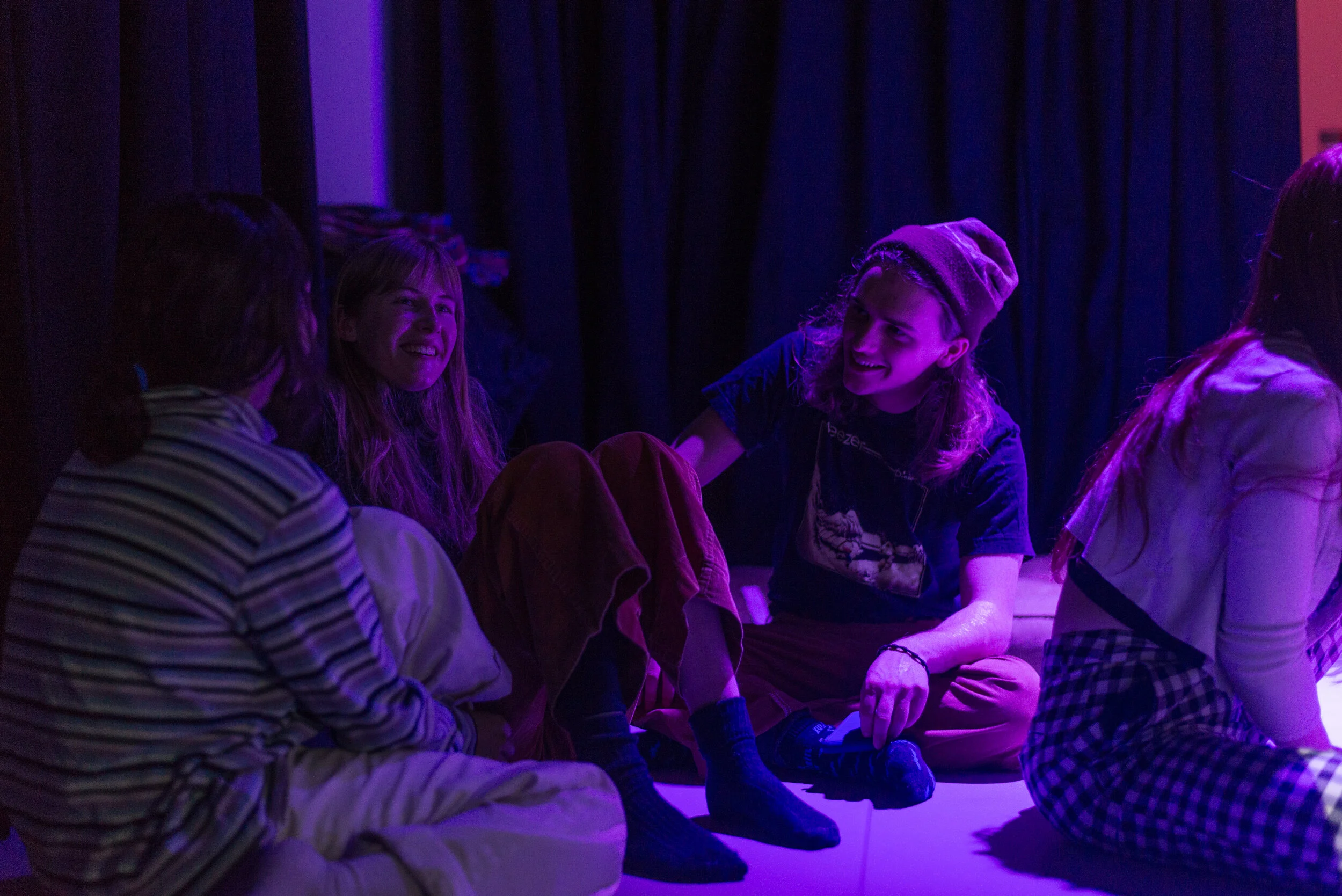Interviewed by Zoe Sottile
Photographs by Sabine Ostinsvil
The Movement Lab is one of the newest additions to Columbia’s artistic culture, an unassuming space that hosts everything from dance classes and coding workshops to film screenings and lighting demonstrations. On March 7th, the Movement Lab became the location for Ratrock’s uniquely interdisciplinary and multi-sensory Winter Featured Artist Show, putting the work of dancers and performers in conversation with painters and architects. The show brought together works by Sarah Courville, Nathan Farrell, Kosta Karakashyan, Gisela Levy, Calvin Hsiao-Sen Yoshiki Liang, Taelor Scott, Miles Zhang, and Anton Zhou. The large empty space was transformed into an experiential gallery, highlighting each artist’s different works and method(s).
Walking into the Movement Lab in the lower level of the new Milstein Library felt like entering an alternate universe. First you descend into the basement from the outside; then you pass through inconspicuous white doors to the gallery exhibition. Taking off your shoes and backpack, visitors leave the miscellany of school behind. The rest of the library was loud, busy and trembling with the stress of upcoming midterms; this space was dark, enclosed and separate. Some of Gisela Levy’s laboriously, delicate papercut works were hung just before the entrance to the movement lab proper. These works were a different experience in viewing - an intricate primer for the rest of the show. The small delicacy of the works contrasted with the larger interactive scale of the works within the dark, multi-sensory space
Cushions were piled into two organic, irregular shapes becoming low seats to sit and face the screens and glowing sculpture at the center of the room. Barefoot visitors gravitated to facing the screens or sculptures, sitting down and then watching as the show unfolded around them. Featured artists’ work was blown up to a massive scale on the lab’s projectors. Since there were multiple screens, the images could be viewed simultaneously side-by-side. Whereas usually the process of looking at art involves isolation - you move from piece to piece, you keep your attention focused exclusively through sight, and the silence of a gallery. At this show, it was almost impossible to resist taking in multiple pieces at a time.
The pieces in the show lent themselves to this simultaneity. The artists designed and curated the show themselves, leading to purposeful intersections of theme and content. Sarah Courville’s collages, for example, put the body under an investigative eye. Her works, which usually fit in the palm of one’s hand, become more than life size on the projectors. On another screen simultaneously, Calvin Liang’s architectural photographs and drawings, which are bodies of another kind, were projected. Myles Zhang’s work similarly contemplates the built world. Zhang’s quick impressions and dynamic watercolor paintings gave a sense of lightness that contrasted with the complexity of some of the other work. Anton Zhou’s stunning oil paintings which often have human subjects, became more powerful in see their intense emotions on a larger scale because it made them feel all the more present.
The space is equipped with technology that enables creative possibilities: an intensive lighting set-up, for instance, painted visitors’ faces with bright colors. Most visitors migrated and clustered in groups and chatting throughout the show, dying down when one of the multiple live performances began. Even before the live performances started, vibrant music filled the space, varying from songs I recognized - SZA’s Weekend - to more experimental pieces. All of the elements came together - the music, the bright lights, the space’s physical separation from the academic stress of campus, the act of sitting on the floor barefoot with strangers - and cultivated a sense of otherworldly-ness and gave me an almost childlike joy. Art shows like this are one of the few moments when Columbia students are brought together by something other than schoolwork.
Throughout the night, Kosta Karakashyan, a Ratrock featured artist and the movement lab’s artist-in-residence, both alone and with other student dancers, began to perform short excerpts of choreography from a showcase in the center of the space. His movements often started out subtle - you might miss them if chatting with a friend or looking at the projected paintings. But gradually they gained dynamism and drew the focused attention of all the visitors. The dancers’ casual outfits, blending in with those of the gallery goers, lent an element of spontaneity to the performance. I never knew when the gallery was going to transform into a dance floor; throughout I was fully immersed in the experience happening around me. Alongside the dancers, Nathan Farrell, a March Ratrock featured artists, performed live music alongside Liam Broderick. His rendition of popular songs, like Frank Ocean’s “Forrest Gump,” contributed to the show’s contemporary atmosphere. Like Kosta’s performances, this live music reinvigorated the idea of the art gallery, breathing new life into an old idea.
And given the multimedia nature of the show, it was impossible to fully separate the dance floor from the gallery. The nature of the projections meant that theoretical intersections between different pieces became real and physical - like when Kosta’s body passed in front of one of Sarah Courville’s collages and the piece was projected onto his skin. Putting these analytic images of human bodies next to Kosta’s living, breathing, sweating works of art demonstrated just how many different ways art can tackle the same subjects.








